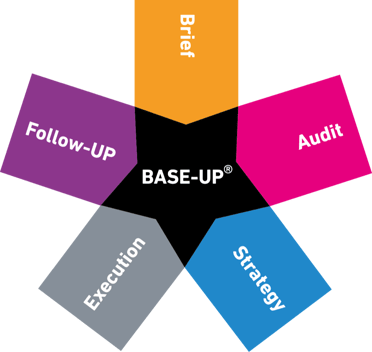When it comes to creating a strong brand, one of the most important elements is making sure you have a value proposition that is true and will resonate with your audience. The entire brand development process needs to go through several important steps designed to uncover your core value propositions and how they relate to your audience. One thing you never want to do is put the cart before the horse…or put your shoes on before your pants.
In brand development, there are obvious questions that must be answered: What are your key messages? Who is your ideal customer? How are you different? What are your competitors doing? What aren’t they doing that perhaps they should?
Then there are the more difficult questions: Have you, in fact, really nailed down WHERE you want to be, or how you are going to get there? Not only are there a lot of questions, they must be the right questions, asked to and answered by the right people.
Let's repeat this together..."Ask the right questions to the right people." This is a key difference between brand development and strategic brand development.
“Perception is strong and sight weak. In strategy it is important to see distant things as if they were close and to take a distanced view of close things."
— Miyamoto Musashi, legendary Japanese swordsman
Even if you don’t know much about UP, you probably know that we do a lot of strategic brand development work. One thing that makes us good at it, is that we follow a well-developed and successful process. We call it BASE-UP®.
BASE-UP stands for Brief, Audit, Strategy, Execution, Follow-UP. It is UP’s project management and branding process that was developed by our company founder Julian Stubbs and has proven over the past decade and a half to be highly robust and successful. If you are at a point of brand creation, or are looking at rebranding, it is critical to have a robust strategic brand development process and tool.
Five reasons to follow a project management process
Let’s explore the UP BASE-UP® project management process and five reasons why you ought to consider it.
 1. Companies are messy, organizations can be even messier.
1. Companies are messy, organizations can be even messier.
We all know that companies can be messy. Often groups within the company may not be aligned in their desires, their focus, or even their strategies. How many times have you looked at a report from another department and wondered what they are thinking?
If everyone is moving forward together, then success takes care of itself.
- Henry Ford
And if you think companies can be messy, organizations or associations can be even worse. Aligning the multiple people, groups, and entities within an organization can be like taming the serpents on Medusa’s head. In life and in business, nothing is static. You are either moving forward, sideways, or backwards. It is important to have clear goals, to know and understand what your purpose is, and to have a strategy. A practical and well-defined strategy is best.
You’ve got to be very careful if you don’t know where you are going, because you might not get there.
- Yogi Berra
The BASE-UP® process is laser-focused on achieving the best strategy for the company, organization or place. In brand creation, as well as in the rebranding process, alignment is critical to success; therefore, after the BRIEF is developed, focus shifts to a paramount part of the process: the Audit phase.
2. Branding a company, organization or a place without a full audit is like a doctor prescribing the treatment without first diagnosing the patient.
Yep, that would be crazy. We could probably just leave it at that. But let’s explore. UP has a strategic brand-building process for a reason. Yes, it works – quite successfully. Okay, that is a reason. But not the one that keeps us using BASE-UP repeatedly.
Branding and advertising work is an interesting animal. It happens from time to time that we are requested to “do the work”, e.g. provide a new identity, tagline, brand palette and yes, even a logo – as part of the pitch – while competing with other agencies to actually “get” the aforementioned project work.
Wait…what?!!?
Yes. And beyond the obvious ethical questions this approach raises, we always wonder how that is even possible. How can anyone provide a legitimate and successful brand strategy, without diagnosing the “patient”?
The AUDIT phase is necessary. This information is key to understanding and knowing the company or organization or place. It is needed to ensure that all stakeholders have been heard and that their requirements are met, or at the very least considered. Without this, there will be no alignment. There will be no success. Trust us, your brand deserves better.
Building a visionary company requires one percent vision and 99 percent alignment.
- Jim Collins and Jerry Porra
A good agency, an ethical agency, won’t prescribe the medicine before they diagnose the ailment. If you are working with an agency, or considering it, asking them what their brand strategy process is would be a good place to start. Then ask to see examples of how it looks in practice. Remember, a logo isn’t a brand.
3. You can’t go to market with a drug before doing the trials and collecting data.
UP is very proud of the work we do in the Life Sciences sector. Many UP members have science and engineering backgrounds, but they happen to be working in a creative business. One might say that UP Members are precision-focused. This can make it rather nerve-racking when asked to provide the STRATEGY prior to the AUDIT, and especially as part of the bid process.
As engineers and scientists, and frankly as those who are really good at what we do, we find it difficult to operate without first collecting data. Would you trust a company that went to market with a drug before they did any testing? Before they did any trials? Before they collected and reviewed any data? The mere suggestion seems ludicrous.
Beyond being absurd, it is not very economical. Sure, it can be done. UP is full of mega talented people. A brand strategy can be devised sans data and provided. But what happens when it is executed? Uh-oh, here comes that “alignment” issue again. It is pretty much a guarantee that if you skip the AUDIT and STRATEGY and go directly from the BRIEF to the EXECUTION, you will end up throwing a lot of money at something that was ill conceived because there was not any proper data utilized to build the STRATEGY.
Would you risk going to market with a drug without any data? If not, why would you revamp your company’s or organization’s entire identity without any data? Ludicrous!
In God we trust, all others bring data.
- W. Edwards Deming
4. The key to successful brands is consistency. It is impossible to be consistent without fully understanding the company, organization, place or product.
Successful companies and organizations are built on consistency. Great brands ooze repetition. If you want to be great at anything – playing an instrument, hitting a golf ball, building a relationship, or whatever, you must approach it with practice, with repetition. You can't "Just Do It" to borrow a phrase. You've got to do it over and over and over again.
You also need to know the “how” of what you are about. If your goal is to be the next golf champion, you darn well better know how to play the game, how to swing a club, and in fact, which club to use. Sure, you can try to do this on your own. You might be super talented…and very lucky, but chances are, you won’t be very effective…and you most certainly won’t be consistent.
With practice you can become good at the game, but being truly great also takes a process, it takes knowledge, it takes creativity. It requires a creative approach, a unique way of following through and a persistent determination to know what great work is. Creating and maintaining a great brand that is consistently effective is difficult. You need to have the input of all the stakeholders (AUDIT), you need to have a solid game plan (STRATEGY), and you will need the full force of all stakeholders to successfully EXECUTE, and deliver.
As an esteemed colleague of mine said: “Great brands are ‘great’ because they get it right.” In essence, these brands follow a process that enables clear thinking, doubles down on new ideas and recognizes that process is the key to creativity.
Getting an audience is hard. Sustaining an audience is hard. It demands a consistency of thought, of purpose, and of action over a long period of time.
-Bruce Springsteen
5. Not using BASE-UP is like putting your shoes on before your pants.
Brief, Audit, Strategy, Execution, Follow-UP. Perhaps now, with a better understanding of the BASE-UP process, you are asking yourself why you would choose to work with an agency that doesn’t utilize this process. We certainly hope you believe your brand creation or rebranding is more important than a beauty contest that involves who can throw out the best looking font, colors and graphics. As we’ve said, sure, the work you are seeking can be done without a strategic brand development process. But will it be done properly? Will your company or organization align behind the outcome? Will it move you forward?
The BASE-UP process guarantees that stakeholders have had a chance to weigh in. It ensures that data has been collected, analyzed, reviewed and acted upon. It ensures that alignment has been a focus of the process. Of course, there are other processes out there. Do your homework. Ask questions about the creative process. Ask about successes.
At UP, we highly recommend putting your pants on, before your shoes. Frankly, doing it the other way is ill-advised.
We are what we repeatedly do. Excellence, then, is not an act, but a habit.
- Aristotle

To read more about the successful use of the BASE-UP® process, look at these case studies:
Axelos: Developing a product-led brand to a global powerhouse using brand development and positioning
Health Incubator Helsinki: Promoting the opportunity of a lifetime for health-related businesses
LGC Genomics: A new position for a genomics giant
Branding projects often start with workshops.
